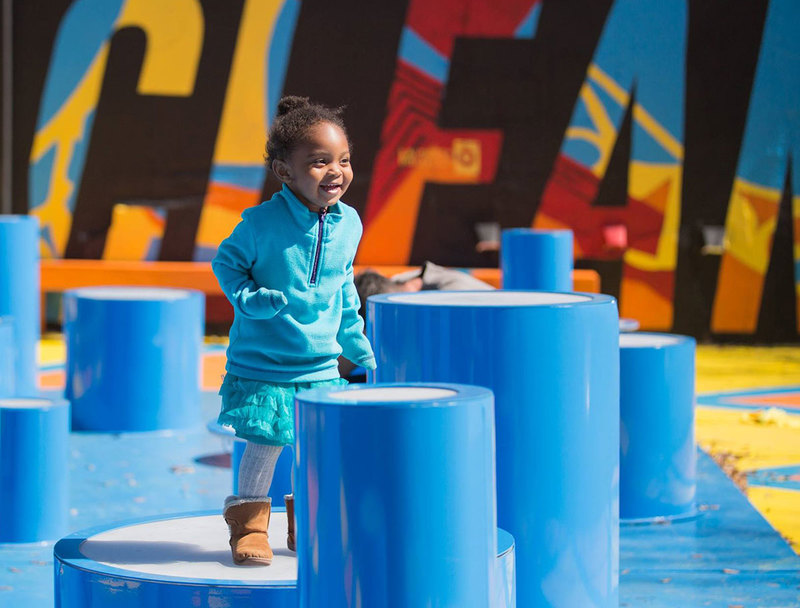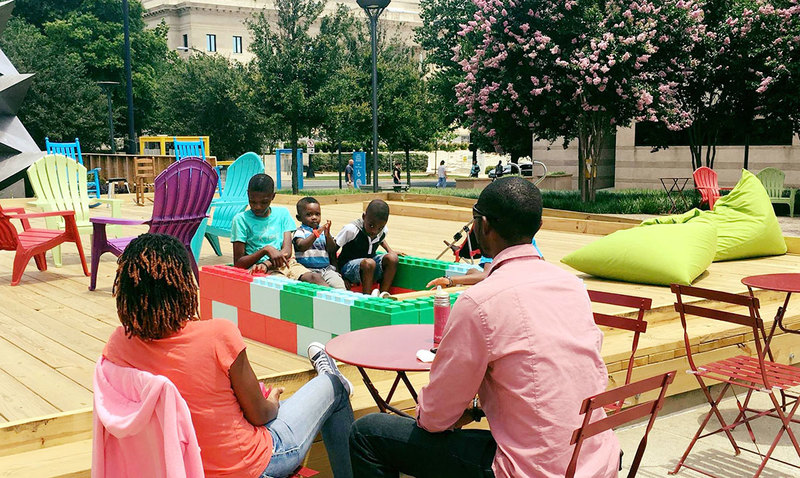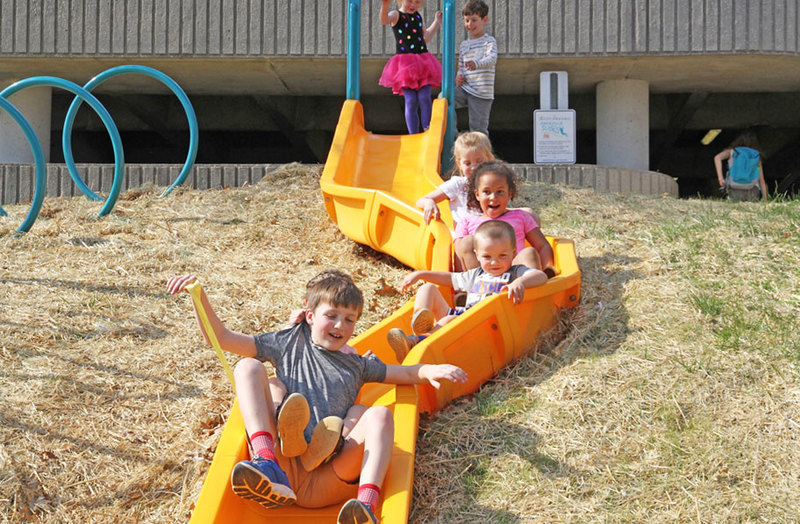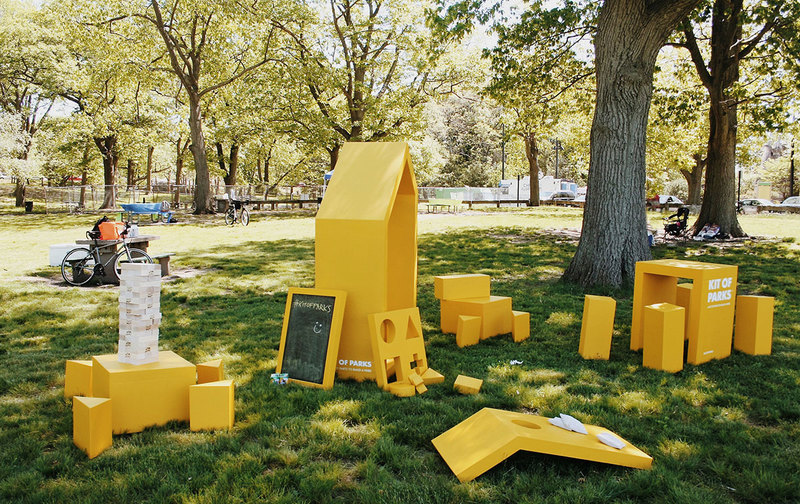Fundamentals
1. Wonderous
Kids find magic in ordinary places, and they’re eager to unravel life’s mysteries. When a place encourages exploration, discovery and imagination, it taps into kids’ innate sense of wonder.
Play is a particularly powerful way to unleash kids’ wonderment, which is infectious. Enabling parents and caregivers to see the world through kids’ eyes can activate their own sense of wonder.
Infusing wonderment into a playspace means designing PLAYces that:
- Surprise, delight and intrigue.
- Stir the senses through color, texture, sound and movement.
- Encourage navigation, investigation and exploration, by providing prompts along the way yet leaving ample space for imaginations to run wild.
- Reveal something new about a place with each subsequent visit, while enabling the wonderment to extend beyond the playspace.

2. Convenient
Kids and families lead hectic lives. Between work, errands and long commutes, family to-do lists can feel endless, making it easy for families to lose sight of the need for play. A dedicated trip to a play destination can feel stressful for a number of reasons, from the logistics of getting there to simply feeling pressed for time.
To overcome these obstacles, play needs to be more convenient. In practice, this means making the decision to play truly effortless. By locating play “along the way,” cities can make play more accessible for families by making it a part of their daily routines. This means putting it in places where families regularly spend time, and bringing it closer to home and school. Designing convenience into a playspace means:
- Locating playspaces along the routes that people regularly travel and in places that can be easily accessed on foot, by bicycle or by using public transportation.
- Selecting locations for playspaces that are already frequented by kids and families for reasons other than play.
- Making playspaces visible, easy to find and easier to return to. Playspaces should be landmarks amid the business of daily life—etched into kids’ mental maps of their city and neighborhood—and magnets for kids when they are close by.
Convenience also means being mindful of the adults who take kids to play, including the time constraints and logistical challenges that affect decision-making when it comes to play. This can be done by:
- Designing spaces that minimize the time, preparation and supervision demanded of parents and caregivers.
- Providing play experiences that are joyful and immersive, yet also finite, with a natural ending that allows families to easily disengage and continue with their daily activities.
3. Inviting
To foster Play Everywhere, playspaces need to beckon and welcome, and instill a sense of belonging. Intentional or not, the designs of public spaces are frequently embedded with unwritten cues that communicate who is—or is not—welcome there. On top of this, kids have an instinctual sense of which places are meant for play. Too often, environmental cues impart the message that certain spaces require “permission” to play, creating the sense that play is an activity that must be separated and demarcated, at the margins of the adult world.

Play Everywhere also requires designing playspaces that invite and welcome. Permission to play should be obvious and intuitive, while design choices should project a sense of safety, security and comfort. To make playspaces inviting means paying attention to even the smallest of details, including:
- Installing signs that explicitly invite kids to play, both in words and through visual and graphic elements that kids can easily interpret.
- Providing clear and easy access to a playspace to eliminate the “hassle factor” of play.
- Making the playspace visible and eye-catching enough to “lead the way” and affirm kids’ sense of arrival.
- Incorporating design elements that help visitors feel safe, welcomed and comfortable: lighting, protection from traffic and, where appropriate, a comforting sense of physical enclosure without deterring potential users with locked gates and other barriers.
Above all, truly inviting spaces should erase doubts by letting kids and families know that it’s okay to play.
4. Shared
By fostering shared experiences, play has the power to spark friendships, strengthen existing ties and teach empathy, all of which form the building blocks of stronger communities. In addition to promoting play, successful playspaces also function as social spaces where the entire community can enjoy play together. They inspire collaboration, facilitate social interactions and help form lasting memories that encourage future connections.
When planning and designing a playspace, it is important to think about the ways in which play can bring kids together and encourage shared activities. At the same time, it is also crucial to remember that parents and other caregivers are the gatekeepers of play. If adults do not feel comfortable and welcomed there, they will not take kids to play there. Therefore, shared playspaces are those that:

- Provide an appropriate mix of independent and social play.
- Inspire conversation and shared laughter.
- Think about the age and ability spectrum to appeal to all users. Is the space easily accessed by all? Will adults enjoy playing too?
- Include comfortable places for parents and caregivers to gather, linger and interact while they watch the kids play. Does the playspace have shaded areas or shelter from inclement weather, or amenities such as restrooms and water fountains?
5. Unifying
Kids at play have a natural talent for unlocking the social life of the city and transcending its divisions. When kids forge friendships across cultures or other divides, adults and entire families can grow closer as well. While play has the power to bring people together, playspaces—like all public spaces—can unintentionally exclude. Unspoken rules and environmental cues, where a space is located and who tends to frequent that location, can influence whether a playspace attracts the entire community. Even the most well-intentioned planning and design decisions can inadvertently discourage potential users from using a playspace by projecting implied messages of exclusion.
A Play Everywhere project is unifying when it:

- Bridges the divides within a community by encouraging new connections among people from all walks of life.
- Enables the act of “coming together,” by being a reflection of the community in its entirety, including its diversity of people, its character and its shared history.
- Draws visitors from all walks of life, while encouraging them to engage with and learn from each other.
6. Challenging
Kids need challenges to grow and develop. By moving beyond their comfort zone, they learn to overcome doubts, test their abilities and evaluate risks. But these opportunities are often hard to find for kids. When a playspace provides ample challenges, it provides a great break from their typical routine, and helps them develop resiliency and grit. It is their first opportunity to learn how to confront a challenge and overcome it in a safe environment.
In playspace design, challenges can come in many forms, including physical, mental or a combination of the two, by:
- Inviting kids to jump higher or think harder.
- Creating “aha!” moments when kids test their limits, by taking what feels like a risk and realizing that they are capable of more than they believed.
- Letting kids set—and then elevate—the bar for what they want to accomplish to keep play fresh and exciting.
These challenges are relative and ever-evolving. The most successful spaces incorporate enough flexibility and degrees of difficulty to accommodate a range of ages and abilities.
7. Intentional
Just as play benefits kids and communities in multiple ways, Play Everywhere has the potential to impact people’s lives and entire communities. When approached intentionally—analytically, deliberately and holistically, with an understanding of the larger patterns, needs and challenges within a community—Play Everywhere can intersect with and support other community priorities, and help solve other community problems.

At the site level, Play Everywhere can breathe much-needed life into everyday physical spaces and daily routines by reclaiming forgotten, blighted or avoided spaces. This includes blank walls, leftover spaces beneath underpasses or along streets, underutilized plazas and unsafe or unwelcoming bus stops. These spaces can be reimagined as community assets and gathering places. An unsafe intersection or auto-oriented street can be transformed into a place for people by painting playful crosswalks or reclaiming portions of a street for play. Designing Play Everywhere projects intentionally means:
- Identifying co-benefits and synergies between Play Everywhere and other community needs and challenges. How can Play Everywhere help solve other community problems, while also increasing the amount of play in kids’ lives?
- Analyzing patterns in a community to identify existing needs and gaps, as well as opportunities, to align Play Everywhere with other community priorities and objectives. These patterns can include demographics, mobility and land use patterns, the distribution of existing parks and playgrounds and safety concern.
- Thinking deliberately about where a Play Everywhere installation is located, who it serves, and who benefits from it to ensure that play reaches the kids, neighborhoods and the urban spaces that need it most.